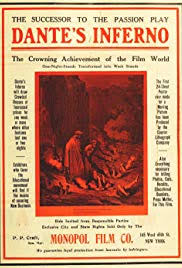
“All hope abandon ye who enter here.”
The poet Dante is on a spiritual journey. He becomes lost in a dark forest having strayed off “the straight and narrow”. He encounters a leopard, a lion and a she-wolf. They represent the vices of avarice, pride and lust. Virgil the poet appears. He was sent by Dante’s deceased love Beatrice to guide him through the nine circles of hell.
At the entrance of hell is a message:
“Through me you pass into the grievous city, through me you pass into eternal pain, through me you pass among the lost people… Abandon all hope, you who enter here.”
Virgil first leads Dante through the portals of hell. They are ferried across the river Acheron by Charon. Once across they descend into the first circle, limbo.
Virgil takes Dante from one circle to another. Along the way they encounter people that Dante knew at one time or another in life. He sees what sin they have committed and what their punishments were. As they pass through each circle Dante is told stories from the various people he knew of how they got there.
Eventually they pass through all the circles and reach Lucifer. In his mouth are the bodies of Brutus and Cassius. The two poets climb down the side of Lucifer to reach the path out of hell. Dante is now back on the correct path, both physically and spiritually.
“L’Inferno” AKA “Dante’s Inferno” was released in 1911 and was directed by Francesco Bertolini, Adolfo Padovan and Giuseppe de Liguoro. It is an Italian film loosely based on “Dante’s Devine Comedy” and influenced by the illustrations of Gustav Dore. It is a silent movie. The film took about three years to make.
There is some nudity in the film, including occasional male frontal nudity. Apparently you don’t need clothes in hell.
The film also has some depictions of Muhammad. Although nothing in the Quran forbids the physical depiction of Muhammad some of the supplemental hadith do. Some allow it, but do not encourage it. Because of this most Muslims avoid physical depictions of any prophet. Of course Dante has him in the eighth circle, fraud. Which would be even less allowed. Dante’s Devine Comedy was written in 1320. Long before tolerance was invented.
It is considered to be the first surviving feature length film.
The nine circles of hell are: 1. Limbo 2. Lust 3. Gluttony 4. Greed 5. Anger 6. Heresy 7. Violence 8. Fraud 9. Treachery
A couple restorations have been done. In 2004 prints from both American and British prints were combined and a music score by Tangerine Dream was done. In 2011 a more complete restoration was done by Italy’s Cineteca di Bologna. It had a choice of a score by Edison Studio or a piano composition by Marco Dalpane.
The special effects are extraordinary considering the film is about 110 years old. They are also quite creepy. Anyone who, as a child, has ever been to Catechism would be scared silly by this film, and none too sure about the validity of the subject matter or not, even if you were atheist.

